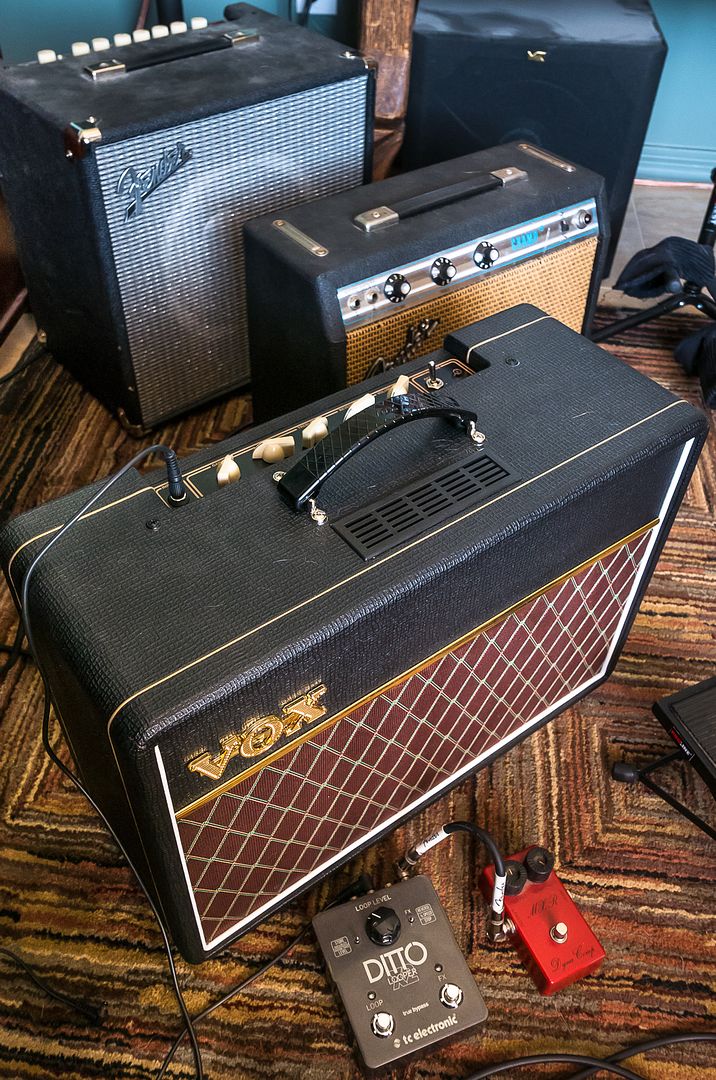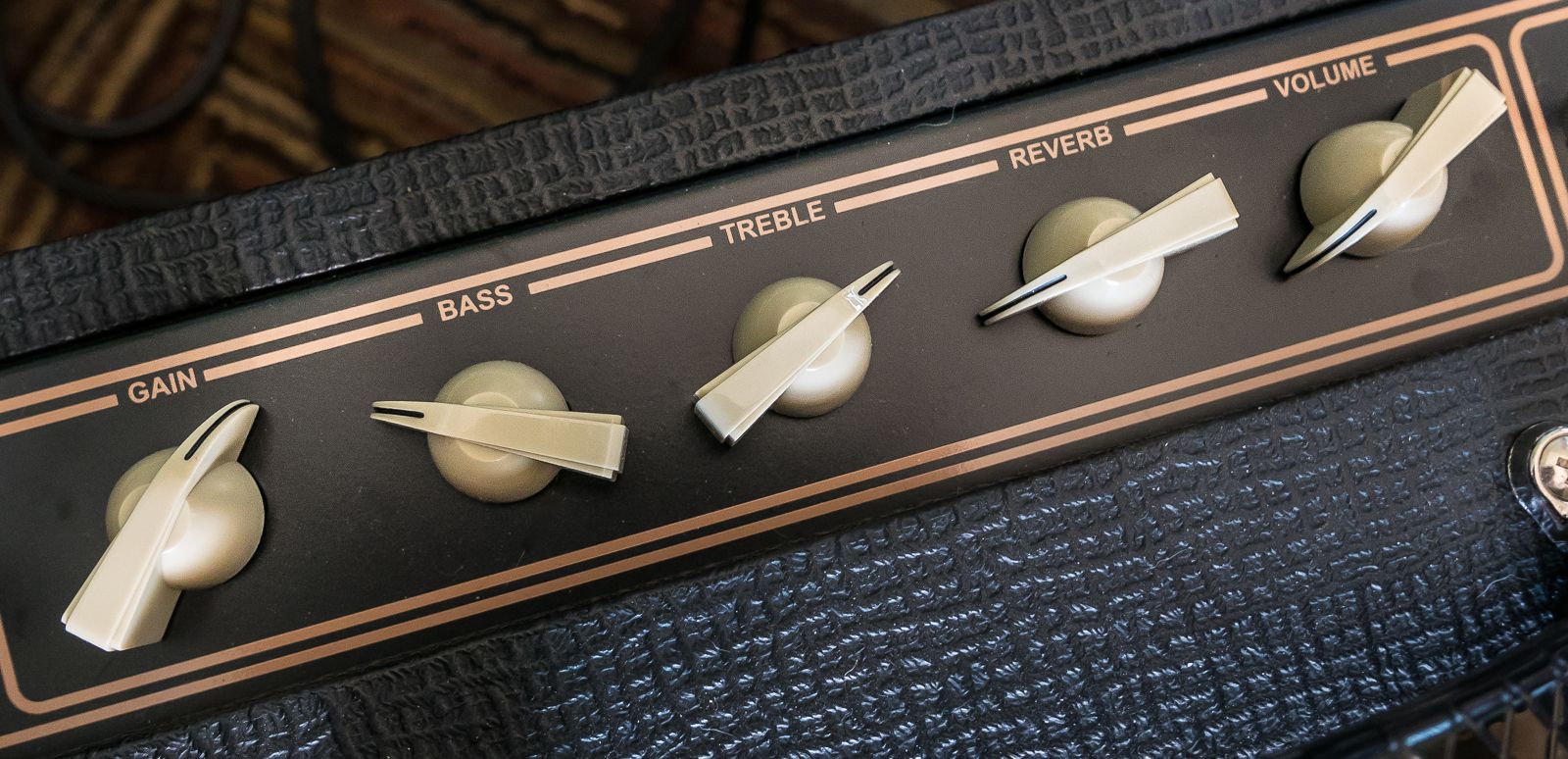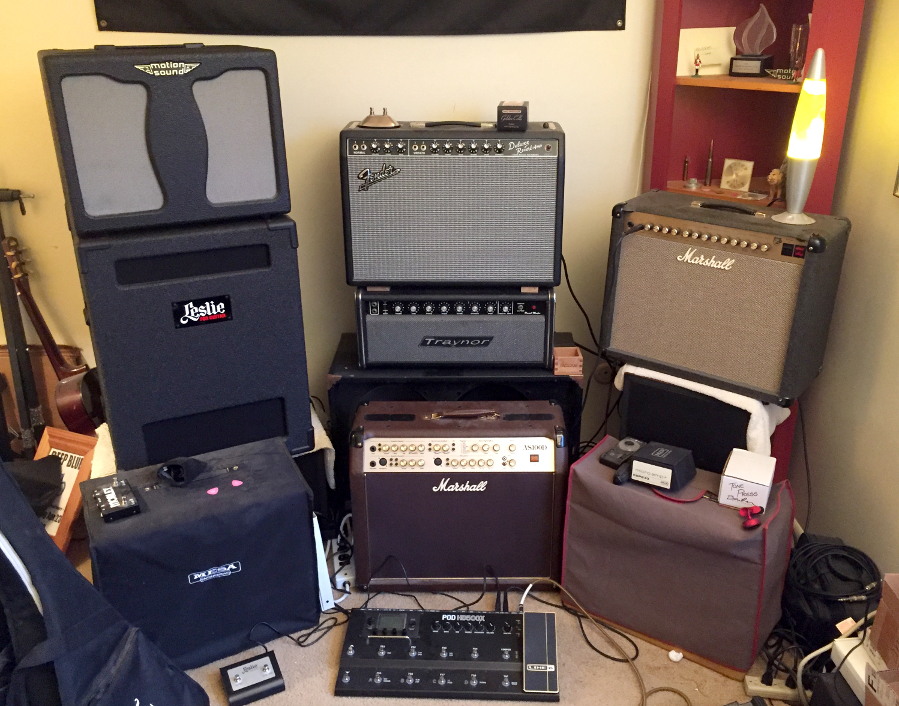
 |
|
#31
|
|||
|
|||
|
If so, don't overlook amps with multiple wattage settings. For example, I gig with a Mesa Express 5:50 Plus which will do 5, 25, and 50 Watts. The 5:25 Plus will give you 25, 15, and 5. That gives me fairly low home volumes but definitely too loud to "crank" at 5 watts. If you think in the future you will want more headroom, you might consider something like these amps, used at home with the volume at manageable levels on 5W, supplemented with a good OD or boost to get the saturation you're after.
To be clear: everyone keeps waxing rhapsodic about a cranked low-wattage amp, but IME the tone and touch sensitivity you get at 5W supplemented with a drive pedal is at least as good as a 1W amp cranked. |
|
#32
|
|||
|
|||
|
Quote:
Definitely want to get realistic breakup at lower volumes, though I'm reading that running tubes at lower power shortens their life, so that's a bummer. I now also understand what you're saying about the lower volume supplemented by a pedal - that's kind of what motivated my original questions. I saw that Andy was impressed by the Supersonic's ability to get the sound w/o a pedal, as if that was a good thing. I wondered why, if a good amp could do, why anyone used pedals - why not just get a good amp? This thread has been eye-opening to me, to say the least. |
|
#33
|
||||
|
||||
|
Everyone talks about there being a "certain... special... sumthin'..."* about driver tube amps that can't be replicated elsewhere. For years I used nothing but driven tube amps onstage and came to realize what it was that the driven amp offered: compression and overtones. The playing feel is a big part of the experience. I struggled to get that sound at bedroom volumes and failed repeatedly. Even a five-watt amp will drive me out of the room and pushes up the SPL in a practice room beyond 85bd. When you understand that I am a recording engineer who must protect my hearing and can't drive my ears like that, you'll understand why I looked for that feel so hard.
I found out how to accomplish it: You have to use a gentle bit of compression to simulate the amp compression. You can add it to a tube amp as you push it up, but the level ends up just as loud as a non-compressed sound, or even louder. The solution is to build a preset in a modeler that has compression to give that spongy power amp saturation feel. Which brings up the other advantage of modelers: you can build patches that can move directly from home to the studio with little or no tweakage. You can also do the same for the stage. And if you feel like you need some of that tube rounding you can always run the modeler into a tube amp. So there are options out there. Bob * Monty Python and the Holy Grail, Swamp Castle, Prince Herbert
__________________
"It is said, 'Go not to the elves for counsel for they will say both no and yes.' " Frodo Baggins to Gildor Inglorion, The Fellowship of the Ring THE MUSICIAN'S ROOM (my website) |
|
#34
|
|||
|
|||
|
Quote:
I'd bet Andy was playing louder than one might expect. You may want to read up on this point, but playing at a lower wattage setting is not the same thing as playing through an attenuator. Somewhat similar results, true, but two completely different things. Running tubes at low power does not shorten their life. Now, some people find that their tubes wear out faster when they use an attenuator, but that's not due to the attenuator per se; the attenuator lets you slam the power tubes pretty much full blast, but tames the volume. The tubes are working at full capacity, so of course they burn out faster, but no faster than if you rented a hall, put on ear protectors, and played your 100W amp full blast every day. |
|
#35
|
|||
|
|||
|
Quote:
I decided to dedicate last evening to the Mustang and FUSE and, guess what? I can see what you're saying. There is a ton of adjustability in FUSE that's not on the physical amp, including multiple pedals and effects that will do just what you say, namely, add a little compression, and the like. OK, well I don't feel like spending my life building/testing presets, but guess what? Others do! And they're available for downloading, so I tested a couple and I couldn't believe I was listening to the same amp I purchased a year ago. Just amazing sound out of that $200 box. So, in addition to considering that perfect low watt amp tone (alone or with a pedal/2), I'll further explore coming up with a group of presets that I can use to fill the 24 slots available in the amp. By that I mean I'll be testing/downloading the excellent work of others. That should keep me occupied for a while. I have run run my POD into a s/s amp, and that was fun - not sure it was that realistic, but I enjoyed it. Thanks for the modeling vote, Bob. |
|
#36
|
|||
|
|||
|
Quote:
I didn't know there was any distinction between an attenuator and a low-watt age setting - thought they meant the same thing. What is it called when it's like a Carr, for example, where you can switch to the full 16 watts, or to a scale with a knob that goes from 4 watts down to 0 watts? Is that a power attenuation? Or just a lower wattage setting? Since I think you can slam the tubes with the max gain with reduced volume, it sounds like an attenuator, if I understand what you're saying, but I'll do some more research on that one. What about the Bugera's triode or pentode things? Another name for an attenuation? Or something else? |
|
#37
|
|||
|
|||
|
Quote:
Low-wattage settings on the amps with which I am familiar give somewhat similar results by actually lowering the headroom of the power tube section (or of how those tubes are used within the circuit) to make them easier to overdrive, so you get similar results. In the end, all you care about (or all I care about, at least) is how it sounds. I'm saying you can get there either way, but they are not the same thing. It's not really as complicated as I may be making it sound, sorry. It's all about clipping. If you're playing through a high-wattage amp and want to drive the tubes into clipping and retain your hearing, you put an attenuator in line between power amp and speaker to reduce volume. If you're playing through a low-wattage amp (say the .1W setting on that 5W Bugera referred to earlier) you can get that same level of clipping and still retain your hearing. If you're playing through anything in the 5W or greater range, IMO, you want to just keep the volume down and use an OD pedal to help slam the tubes without adding any appreciable volume. Honestly, I don't know the effect of triode versus pentode on wattage, just that they give you a different amount of "sag", so feel different when you play them. I suspect any effect on wattage is pretty minimal. I had a Mesa Mark V once, and that's what I noticed in the different triode/pentode settings. They felt different, but I never noticed any appreciable volume difference. |
|
#38
|
|||
|
|||
|
I never met a distortion pedal that I really loved the sound of - they just sound too artificial and 'fuzzy' to me.
For me, a good low-powered tube amp, having a gain & a master control, along with a DynaComp Compressor gives me fabulous mildly overdriven tones that I couldn't be happier with. I love the tone of my 70's Champ with 10" Weber, but it's got to get a bit up there in loudness to achieve the amazing tone - it doesn't have a master. For me a little bit too loud in my home music room. Keeping the budget reasonable, I went with the VOX AC10, which is a valve amp, and still use the vintage DynaComp Compressor that I bought in 1975. Having the gain and master, then spending a good bit of time to find just the right settings, gives me rich, awesome, mildly over-driven break-up tones without getting too loud for my home music room. I'm definitely not into heavy distortion/overdrive/fuzz. Yuck. I like Fendery-clean tones, but just on the edge of break-up, with compression tones. The AC10 and Dyna-Comp do a pretty great job of that.  
Last edited by DHart; 08-25-2017 at 02:00 AM. |
|
#39
|
|||
|
|||
|
Quote:
My Fender Passport Mini and the Fuse software totally changed my mind. I get far better tones out of it than my Laney's organic sound. I now augment the Laney with a multi effect pedal. The Fuse software is excellent IMO and actually does a pretty good job of replicating the amp models it represents - I know, because I have owned or played through many of them. Tinker with the Mustang a while. I think you will find that the answer you seek may have been in your closet.
__________________
Roy Ibanez, Recording King, Gretsch, Martin G&L, Squier, Orange (x 2), Bugera, JBL, Soundcraft Our duo website - UPDATED 7/26/19 |
|
#40
|
||||
|
||||
|
Oh, and by the way, I didn't dump the tube amps:
 The Champy and Gretsch are at work. Bob
__________________
"It is said, 'Go not to the elves for counsel for they will say both no and yes.' " Frodo Baggins to Gildor Inglorion, The Fellowship of the Ring THE MUSICIAN'S ROOM (my website) |
|
#41
|
|||
|
|||
|
Quote:
If modeling is on the table I'll comment on my experiences with a Mustang II (my sons), a Marshall Code25 and a Line6 Firehawk FX. The first comment echos some others - you really have to dig into the software in my experience to get the best tones out of these amps and effects. I've yet to encounter a preset in any of them that I liked "out of the box". Admittedly I've not explored user uploaded presets from the various clouds but the stock ones generally don't get me to what I want. The Marshall and Line6 use Bluetooth apps (I repurposed an older Nexus 9 tablet as my "music" device) which makes them relatively easy to tweak - the Fender needs a PC but the interface is good and easy enough to manipulate. With some fiddling I have gotten some really good sounds from all of them. They have their relative strengths - not surprisingly I found the Marshall to get the best gain models - the Fender the best cleans and the Line6 is probably the most versatile in terms of a variety of good models. Which is not to say they can't do other things but those seemed to be the best. The only issue I encountered is that while I'm not in a band I'm working with a friend to start one - and my band rig is a 40watt tube combo with a pedal board. So to practice I wanted to use my pedals to more closely mirror the bigger/louder setup and to explore the pedal options and combinations (a few of the pedals are still relatively new to me). While I could pick, say, the "fender" clean setting on the Marshall and run the pedals into the front end (or even a JVM clean) I did find that while some pedals seemed to work OK (chorus, compressor and delay) - the amp didn't seem to respond as well to overdrives (in my case a T Rex Moller, vintage TS10 and EH Soul Food). The Moller and the Soul Food sounded OK - not as good as into the front end of the tube amp but stlll usable just not as good, but whatever the TS10 circuit does befuddled the Marshall digital converters and it sounded like a swarm of angry hornets. Totally unusable. Used by itself with the built in effects (I do not have the Marshall Code foot controller which might make it more user friendly but new at least they are pricey - nearly half of what I paid for the amp used) it sounds really good given the size/speaker limits. The onboard effects are not as diverse as the Line6 but are all usable and sound good. I haven't used pedal into the Fender so I won't comment on that but the general consensus is that overdrives in particular don't pair well with digital modeling amps but it may be interesting to try it with the Mustang. The Line6 is a different beast - it can be used with an amp although I haven't gone through the experiments (4 cord or otherwise) and have used it with headphones at this point. Regardless if you want to amplify it you need something in addition - a FRFR or an amp (ideally with an effects loop). Without question I see the appeal of modeling amps and simulators - you get a dizzying array of options and the technology to my ear at least has gotten to a point where they mostly sound really good. Heck there is a great Anderson's TV YouTube video where they blind tested a range of classic amps against their profiled versions in a Kemper and two seasoned guitarists could not tell the difference with any reliability. Now the Kemper is in a different league and price point but it goes to show how far the technology has come and even at lower price points some of that has trickled down. There is another video comparing an original 20yo POD to the Kemper and the Amplifire and while the POD loses ground in higher gain models it sounds surprisingly good matched against one of the best and most expensive setups in the Kemper and a well regarded "mid range" modeler in the Amplifire. Another factor is cost. Even being thrifty and buying used my two tube amps and pedals all in over time have cost me roughly $1300. New and or current market value (I have two vintage pedals I bought years ago that would cost me 4x what I paid for them back in the day to replace) would be a good bit more than that (north of $2k). And that doesn't include all the patch cables for the pedals, a power supply for the pedals and the time to build a pedal board which I still need to do... which adds up. At that price you could easily get a Helix and either a solid amp or FRFR - and you're within the range of an AxeFX or Kemper - although you'd still need a FRFR or with the Kemper power head a cabinet. And you'd have a much wider palette of options at your disposal. I can also see once established in a cover band setting the flexibility of a modeling setup with preset patches for the entire set list would be a really attractive option. I heard a band recently who were Cracker Jack players - all covers but everything from Tears for Fears to AC/DC and Whitesnake - and the two guitar players and the bass player had not an amp in sight - all POD floor setups (one Helix and one POD500x) through the PA and in ears. They sounded great in a live bar room. Spot on tones for all of that variety. And their load in/out was a lot easier too! While I'm not crazy about the spider amps themselves - I think the PODs sound better to my ear - the Mustang amps, the Marshall Codes, the Vox Valveronix and the Boss Katana are all affordable and sound really good if you put the time into tweaking. So while I've settled for the moment on a pedals/amp setup some of that is driven by being old and used to that convention after x number of years (albeit with a 10 year layoff of very sporadic playing) - some of it is that I already had some pedals that I was familiar with - and some of it is just driven by how I currently practice and am building back my chops. But I have not written off modeling at all - I can easily see as my opportunities to play with other musicians advances (what I miss the most about playing actually having been in bands in high school, college and graduate school) working the Firehawk FX into the setup as a more flexible and portable solution to achieving a wide range of sounds.
__________________
Taylor 517e Yamaha AC3R PRS Custom 22 semi special PRS Custom 24 Rickenbacker 330 Teles (too many) Bad Cat Cub III 30R Goodsell Super 17 Vintage Sound VS22 Too many pedals! |
|
#42
|
|||
|
|||
|
Quote:
That Bugera triode/pentode thing seems to be discussed in the same context others use to discuss wattage reductions. |
|
#43
|
|||
|
|||
|
Quote:
|
|
#44
|
|||
|
|||
|
If I had Bob's arsenal, I'd be living alone. Very sweet (the arsenal part).
|
|
#45
|
|||
|
|||
|
Quote:
|